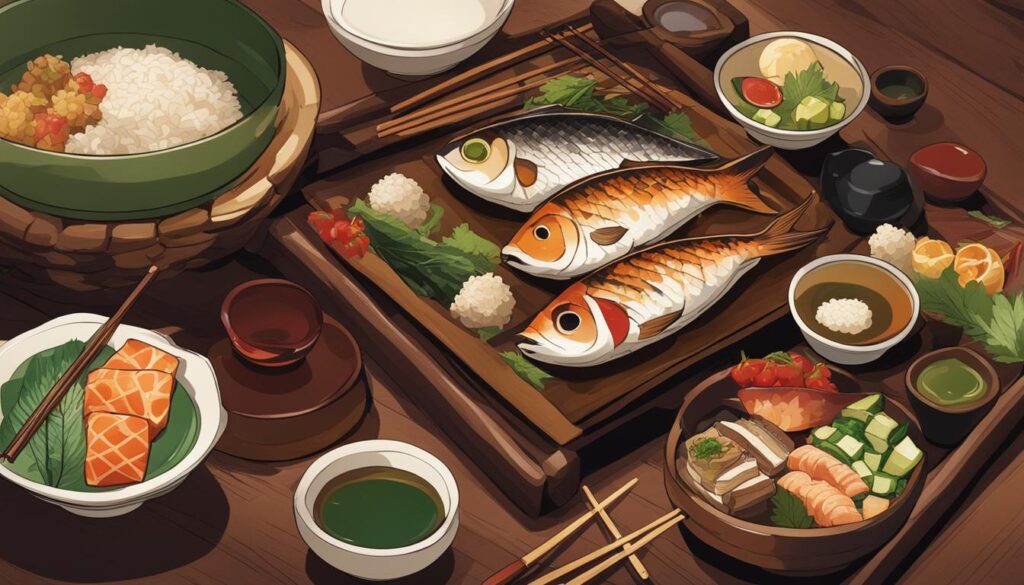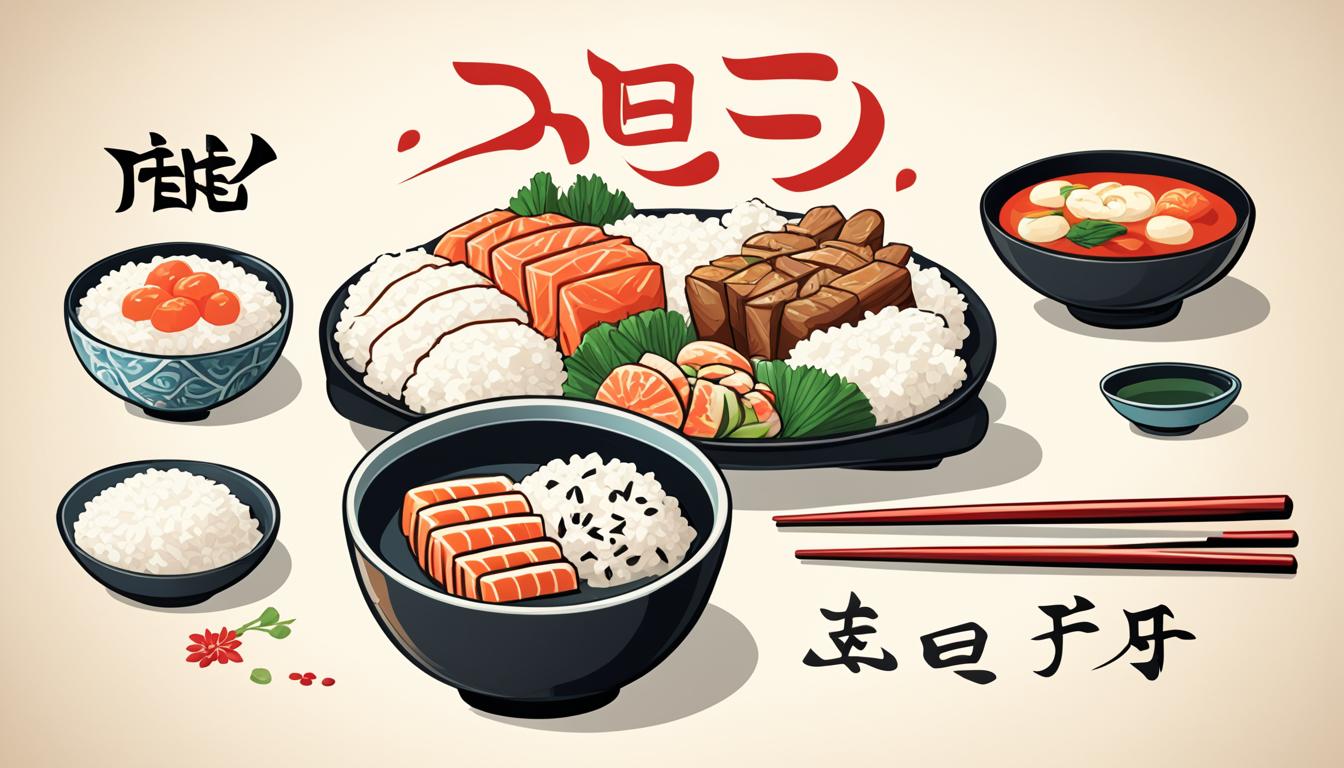In this article, we will explore the different ways to say “dinner” in Japanese and provide a quick guide to help you learn and pronounce the Japanese word for dinner. We will also provide translations and explanations so you can enrich your vocabulary for your next trip to Japan or conversation with Japanese-speaking friends.
When it comes to the Japanese word for “dinner,” there are several options to choose from, each with its own nuances and contexts.
The most commonly used term for “dinner” in Japanese is “夕食” (ゆうしょく, yuushoku). This word specifically refers to the evening meal and can be used in both formal and informal situations. If you prefer a more casual way to say dinner, you can use “夕飯” (ゆうはん, yuuhan) or “晩ご飯” (ばんごはん, bangohan).
Additionally, you can express “dinner” using the katakana writing system with the word “ディナー” (でぃなー, dinaa). This is often used in more Westernized contexts or when referring to specific types of meals.
It’s important to note that the choice of words for “dinner” may vary depending on the region or personal preference.
Now that you know how to say “dinner” in Japanese, let’s take a closer look at the meaning, grammar, pronunciation, and cultural usage of this word.
Meal in Japanese
In Japanese, the word for “meal” can be translated to “食事”(しょくじ, shokuji) or “ご飯”(ごはん, gohan). These terms encompass not just the act of consuming food, but also the significance of coming together to share and enjoy meals while strengthening bonds and sharing culture and traditions.
Japanese cuisine embraces the concept of mealtime as an opportunity for communal connection and appreciation. It goes beyond the mere act of eating and recognizes the importance of socializing and building relationships through the sharing of food.
The Japanese word for meal, “食事” (shokuji) conveys the idea of a complete dining experience, where food takes center stage in fostering unity and harmony. It encompasses the notion of savoring each bite, not just for nourishment, but for the cultural and emotional significance it holds.
Similarly, the term “ご飯” (gohan) refers specifically to rice, a staple of Japanese cuisine. However, it is commonly used to refer to a meal as a whole, as rice often forms the foundation of Japanese dishes. Through this word, the Japanese recognize the central role that rice plays in their daily sustenance and cultural identity.
Meals in Japanese culture are occasions to celebrate and appreciate the art of cooking, the flavors of seasonal ingredients, and the connection between family and friends. It is a time to express gratitude for the sustenance provided and to forge lasting bonds over shared culinary experiences.
| Japanese word for meal | How to say meal in Japanese | Meal translation in Japanese | Japanese equivalent of meal | Meal word in Japanese |
|---|---|---|---|---|
| 食事 | しょくじ (shokuji) | Meal | 食事 | しょくじ (shokuji) |
| ご飯 | ごはん (gohan) | Rice/Meal | ご飯 | ごはん (gohan) |
Breakfast in Japanese
To refer to breakfast in Japanese, you can use the term 朝食 (ちょうしょく, choushoku) or 朝ごはん(あさごはん, asagohan). These terms specifically refer to the morning meal and can be used in both formal and informal contexts. “朝ごはん” (asagohan) is a more casual and commonly used way to say breakfast in Japanese.
Enjoy a traditional Japanese breakfast, known as “asagohan”, which typically consists of steamed rice, miso soup, grilled fish, pickles, and various side dishes. It is a wholesome and nutritious start to the day, reflecting Japan’s emphasis on balance and presentation in their cuisine.
Whether you’re visiting Japan or exploring Japanese culture, learning how to say breakfast in Japanese can enhance your understanding of the language and provide you with an appreciation for the rich culinary traditions of this fascinating country.
Lunch in Japanese

When it comes to the midday meal, there are several ways to say “lunch” in Japanese. The most common term is “昼食” (ちゅうしょく, chuushoku). Another way to refer to lunch is “お昼” (おひる, ohiru) or “昼飯” (ひるめし, hirumeshi). Additionally, the word “lunch” can be expressed using katakana as “ランチ”(らんち, ranchi).
These different terms for lunch can be used interchangeably, depending on the level of formality and the context. Whether you’re in a casual setting or a more formal environment, you can use any of these words to refer to your midday meal.
So, next time you’re in Japan and looking to grab a bite to eat around noon, remember to use one of these expressions to order your delicious lunch!
Dinner in Japanese
To say “dinner” in Japanese, you have several options:
- 夕食 (ゆうしょく, yuushoku)
- 夕飯 (ゆうはん, yuuhan)
- 晩ご飯 (ばんごはん, bangohan)
- ディナー (でぃなー, dinaa)
These terms specifically refer to the evening meal and vary in formality and common usage. Let’s take a closer look at each term:
| Japanese Term | Pronunciation | Meaning |
|---|---|---|
| 夕食 | ゆうしょく | The word “夕食” (ゆうしょく, yuushoku) is used to refer to dinner in Japanese. It is a formal term commonly used in various settings. |
| 夕飯 | ゆうはん | “夕飯” (ゆうはん, yuuhan) is a more casual term for dinner. It is commonly used in everyday conversations. |
| 晩ご飯 | ばんごはん | The term “晩ご飯” (ばんごはん, bangohan) is another casual way to say dinner in Japanese. It is often used in informal settings. |
| ディナー | でぃなー | The word “ディナー” (でぃなー, dinaa) is borrowed from English and is commonly used to refer to a formal dinner or a Western-style dinner. |
Now that you know how to say “dinner” in Japanese, you can confidently navigate conversations and enjoy delicious meals during your trips to Japan or when dining with Japanese-speaking friends. Itadakimasu!
Food in Japanese
When it comes to discussing food in Japanese, there are two main terms you can use: “食べ物” (たべもの, tabemono) and “食品” (しょくひん, shokuhin). These words encompass the wide variety of ingredients and dishes that make up the Japanese gastronomic landscape.
Japanese cuisine is known for its artistry and attention to detail, focusing on fresh and seasonal ingredients. From delicate sashimi to flavorful ramen, every dish is thoughtfully prepared to showcase the natural flavors and textures.
The Japanese word for food reflects the deep connection between culture, nature, and sustenance. It captures the essence of the country’s culinary traditions and the importance of food in daily life.
From traditional dishes like sushi, tempura, and miso soup to modern creations like Japanese-style curry and matcha desserts, Japanese food offers a diverse range of flavors and experiences.
Exploring Japanese food is not only a tasty adventure but also a way to delve into the rich history and traditions of the country. Whether you’re a fan of seafood, vegetables, or meat, the Japanese culinary world has something to satisfy every palate.
Meat and Vegetables in Japanese
When it comes to the protein-rich element of Japanese cuisine, the word for “meat” is 肉 (にく, niku). The word for “vegetables” is 野菜 (やさい, yasai). These terms are used in various dishes and add depth and flavor to the rich culinary world of Japanese cuisine.
Japanese Word for Meat: 肉 (にく, niku)
How to Say Meat in Japanese: にく (niku)
Meat Translation in Japanese: 肉 (にく, niku)
Japanese Equivalent of Meat: 肉 (にく, niku)
Meat Word in Japanese: 肉 (にく, niku)
Meat Meaning in Japanese: 肉 (にく, niku)
Japanese Word for Vegetables: 野菜 (やさい, yasai)
How to Say Vegetables in Japanese: やさい (yasai)
Vegetables Translation in Japanese: 野菜 (やさい, yasai)
Japanese Equivalent of Vegetables: 野菜 (やさい, yasai)
Vegetables Word in Japanese: 野菜 (やさい, yasai)
Greetings and Phrases Related to Meals in Japanese
In Japanese culture, expressing gratitude and appreciation before and after a meal is considered important. When sitting down to eat, it is customary to say “いただきます” (Itadakimasu) as a way of giving thanks for the food and acknowledging the effort that went into preparing it. This phrase reflects the deep respect for food ingrained in Japanese society.
“ごちそうさま” (Gochisousama) is said after finishing a meal to show gratitude and appreciation. This phrase conveys thanks not only to the person who prepared the meal but also to all those involved, including the farmers and fishermen who provided the ingredients. It is a way of acknowledging and respecting the interconnectedness of the food system.
Both “Itadakimasu” and “Gochisousama” encompass more than just words of thanks. They represent a mindful approach to eating, emphasizing gratitude, respect, and the acknowledgment of the labor and resources that go into nourishing our bodies. By incorporating these phrases into your meals, you can honor Japanese culture and deepen your appreciation for the food you enjoy.

